Disclosure: Meeple Mountain received a free copy of this product in exchange for an honest, unbiased review. This review is not intended to be an endorsement.
Snakes. Why’d it have to be snakes?
I grew up in the 80s, a decade of bizarre fashion, questionable hairstyles, and Saturday morning cartoons. Mr. T had his own brand of cereal and Pee-Wee Herman was dancing on top of a bar in Texas. It was also a phenomenal decade for movies. Star Wars mania had firmly taken hold, Back to the Future was released, Rambo sneered at us from the big screen, and E.T. wanted to “phone home”. And right there in the middle of it all was Indiana Jones cracking his whip, punching fascists, and unearthing ancient artifacts and ruins.
Doctor Jones made my head spin with fanciful dreams of becoming an archaeologist some day. He had me running around in my yard pretending that every obstacle was a booby trap cleverly laid in wait by some long forgotten civilization. As I rolled around in the leaves and crawled over and under my playground equipment, I was a brave explorer rescuing lost treasures from the clutches of ne’er do wells. I’m sure I wasn’t the only one.
As the years went by, I began to realize that the archaeology performed for my entertainment on the big screen was a far cry from the actual archaeology performed in the real world. Even though my adult brain understands that now, the idealized version of archaeology that Doctor Jones exemplified has never left me. No doubt, this is why games like Tomb Raider and the Drake’s Fortune series resonate so well with me. They allow me to live out those childhood dreams without the inherent dangers of actually doing so.
Needless to say, I was excited when I learned about Lost Ruins of Arnak. The cover art features a rugged explorer, chest puffed out proudly. To his left stands a woman holding a pair of binoculars in her hand pointing excitedly to some ruins towering through the fog in the distance. As an ex-archaeologist wannabe, it’s impossible to look at this scene and not feel those embers of adventure I’d thought long dead stirring once again.
But can a board game stoke that spark into a fire?
Overview
Lost Ruins of Arnak puts the players into the hiking boots of adventurers exploring the mysterious island of Arnak. Within the island’s verdant jungles hide mysterious ruins, ruins which hold valuable treasures and even more valuable knowledge about the lost civilizations that built them. Using a combination of deck building and worker placement, players will take turns sending their Archaeologists to the various areas of the board to collect resources, explore temples, fight the guardians that reside within, and record their newfound knowledge for posterity. All of these things earn the players points and the person with the most points at the end wins.
When the game begins, every player has an identical set of cards that can be used for their abilities or for the icons which will be needed for them to travel to the different sites sprinkled around the board. Traveling to one site, for instance, may cost the player three compasses and one boat icon while travelling to a different one may call for six compasses and two automobile icons. The basic starter cards provide either compasses or coins in addition to their travel icons (although a card can only be used for one or the other). Additional cards will be revealed and be available for purchase that can be used to bolster the players’ decks. These cards have more powerful abilities that will enable players to accomplish greater things more quickly on their turns.
In addition to sending their explorers to the hidden temples and battling the guardians that protect each one, the players will also be turning some of their focus to the Research track where new discoveries are chronicled for victory points. The Research track is divided into tiers. Moving from one tier to the next requires specific resources. If a player is the first player to reach a certain tier, they will also earn valuable Research Bonuses. The higher you are able to ascend on this track by the end of the game, the more victory points you will earn.
Of course this is a high level overview of Lost Ruins of Arnak. If you’d like to learn more about how the game is played, then click on the bar below. Otherwise, feel free to skip ahead to the Thoughts section to see what I think about the game.
Adventurer’s Log Day One: Today we began our journey…
The setup for Lost Ruins of Arnak, while fairly easy, can also be time consuming so you might want to draft another player to assist you. First you’ll unfold the game board and lay it flat on either the Bird Temple side (easy) or the Snake Temple side (advanced). Next, separate the cards by type: Artifact, Fear, Item, and Starting cards. Shuffle the Artifact and Item cards to form their own decks. Each deck is placed face down into the marked location on the board. One Artifact is drawn and placed face up into the leftmost card position and the other five spots are taken up by Item cards drawn from the Item card deck. The Moon Staff is placed between these. It acts as both a separator and a game timer as you will soon see.
The Fear cards have their own location. Each player will receive two of these in addition to a pair of Funding cards and a pair of Exploration cards (each pairing should have different travel icons on them) from the Starting cards to create a starter deck of six cards. The players then shuffle these six cards and place them face down in their play areas.
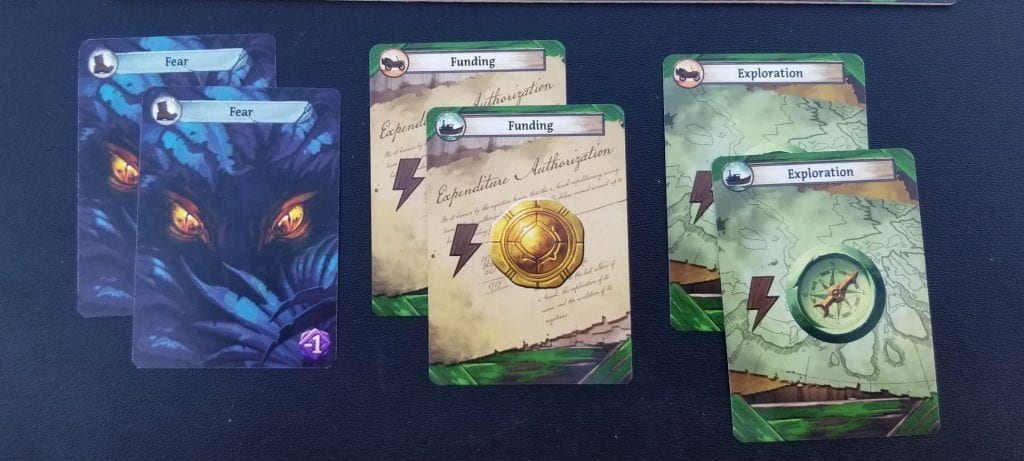
Having dispersed all the cards, it’s time to finish setting up the rest of the game board. Each resource has its own storage location at the bottom of the board. Above the storage areas are the travel sites. Each of these receives one to two random Idol tokens (the total is shown on the space) face up except for the upper tier sites which receive two Idols, one face up and one face down.
To the right of this area is the Research track. Each tier of this area receives a random face down Research Bonus token. Once these have all been placed, return the unused ones to the box and flip the ones you placed face up. The very top of the Research track has spots for two point, six point, and eleven point tiles. Each spot is filled with its proper tile type and a number of tiles equal to the player count. There are three spots for two point tiles, two for the six pointers, and one for the elevens.
Beneath the Research track is an area for the Assistants. These are shuffled together and placed onto their locations, silver side up, into three equal sized stacks. Beneath these are the Site tiles, Level 1 Guardian tiles, and Level 2 Guardian tiles. Each of these tile groupings are shuffled and placed face down as decks into the marked spots on the game board.
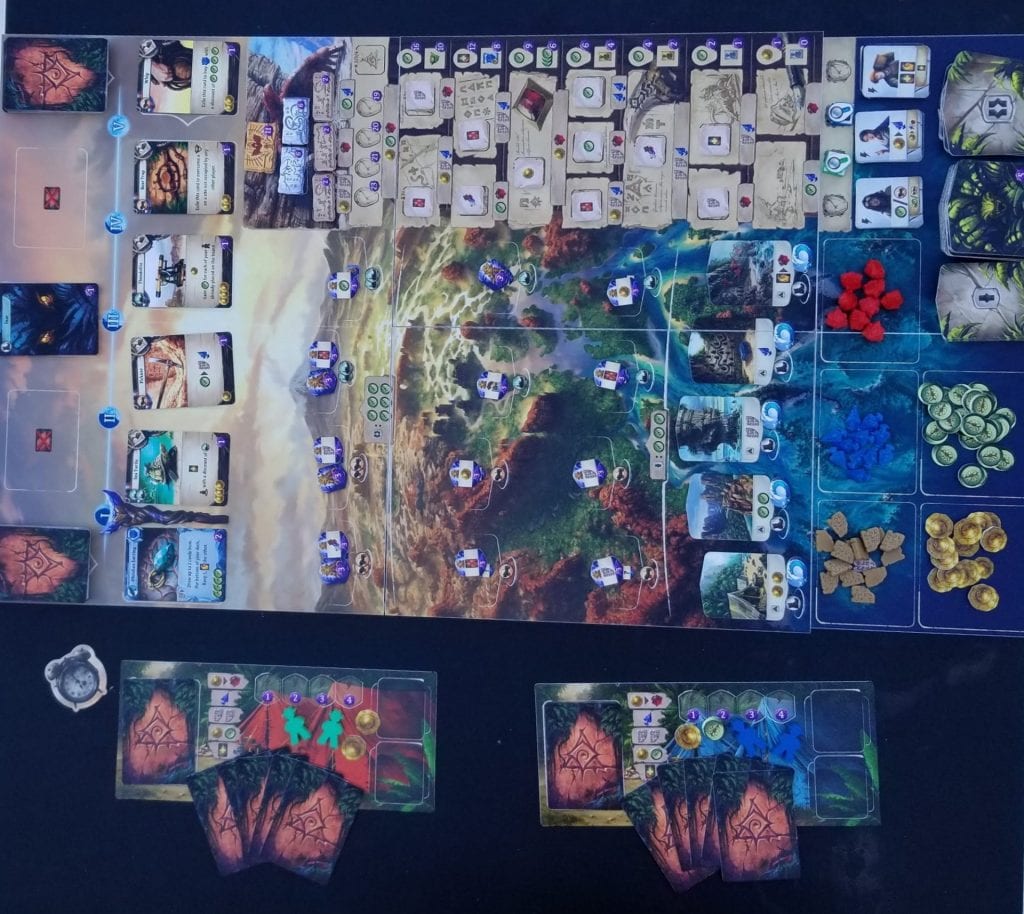
Now, the players each receive a player mat which they place in front of themselves tent side up. The back side is only used in a solitaire game (which I will not be covering in this review). They also receive two Archaeologist pawns, a Notebook token, and a Magnifying Glass token in one of the player colors (red, green, yellow, or blue). The Archaeologists are placed onto the playmats. The Notebook and Magnifying Glass tokens are stacked together and placed onto the Research Track area directly above the Research Assistants, with the Magnifying Glass on top.
Finally a start player is determined by some means and receives the Start Player marker while all players receive starting resources based on their player order. With that, you are ready to begin playing Lost Ruins of Arnak!
Adventurer’s Log Day 12: At long last, we have arrived.
At the beginning of a round, each player will draw five cards from their deck and these will be the only cards they will be able to use for the remainder of that round. The length of a round is different for each player and dependent entirely upon how they choose to use their cards and which actions they perform. Some actions require more resource and icon combinations to perform than others.
There might even be some cards picked up later on that will allow players to add more cards to their hand which can extend the time they are actively playing in the round. Because, you see, the round will come to an end once every player has passed. Once you’ve passed, you’re done for the round and cannot come back in later on. This may sound like there’s a good chance one or two players are going to find themselves sitting there watching other people take turn after turn before the round blessedly draws to a conclusion, but this has not been the case in my multiple plays. The turns go by fairly quickly and, at the most, other players might get one or two extra turns out of their card draws before they, too, are done for the round.
During each player’s turn, they may perform one action before it becomes the next player’s turn. These actions are:
- Buy a card
- Play a card
- Dig at a site
- Discover a new site
- Overcome a Guardian
- Research
- Pass
There are also free actions which do not count against the “one action per turn” limit and these are characterized by the lightning bolt icon that accompanies the action. Some of these free actions are supplied by the player’s cards, but they may also come from Research Assistant abilities or even conquered Guardians. All of these actions and the game-specific terminology will be explained shortly.
The first two actions, buying and playing cards, require very little explanation. At the beginning of each round there will be six cards available for purchase. The Item cards each have a gold cost (paid with coins) associated with them. To purchase one, you just need to pay the gold cost to the general supply. Artifact cards are treated in the same manner except they are purchased by paying a number of compass icons. The empty hole left behind is filled by first sliding the remaining cards towards the Moon Staff and then drawing a new card to fill the empty spot.
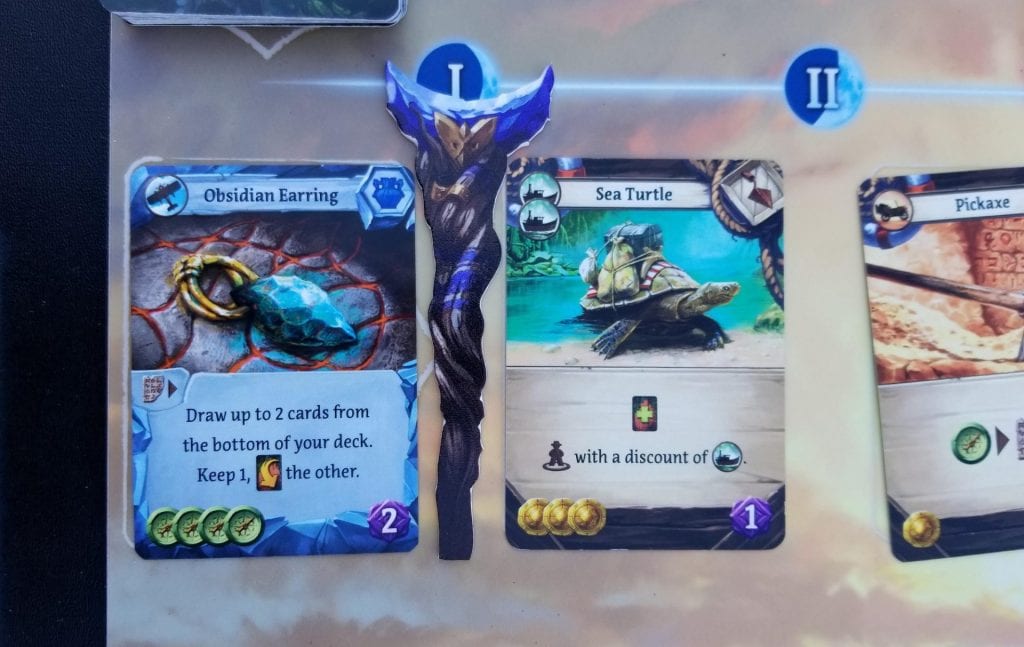
Purchased Item cards are added to the bottom of your deck. This is a key difference from most other deckbuilders that will typically have you add the newly acquired cards to your discard pile where they will eventually be reshuffled into your deck at a later time. In Lost Ruins of Arnak you are guaranteed that you will be able to use at least some of your new purchases during the next round and you even know precisely which ones since you’re the one that put them there. This allows for a level of control that most other deckbuilders simply do not afford you. That being said, at the end of a round you will be gathering all of the cards used that round, shuffling them, and placing them beneath the other cards in your deck. So unless there were at least five cards left in your deck before doing this, there will still be some uncertainty, but you will never be completely in the dark (unless your deck was completely empty at the end of the round).
Artifact cards are a little different. In order to use an Artifact card in future turns, there is an associated tablet token cost that must be paid. However, the first usage of an Artifact card is free. Once purchased, the card is placed into your playing area and you may use its ability.
On your turn you can play as many cards into your playing area as you like. With the exception of Fear cards, every card in the game has some kind of ability that makes it unique. Each card also contains a travel icon (one to two boots, cars, or boats). When you play the card, you choose which function you’ll use the card for but it can never be used for both.
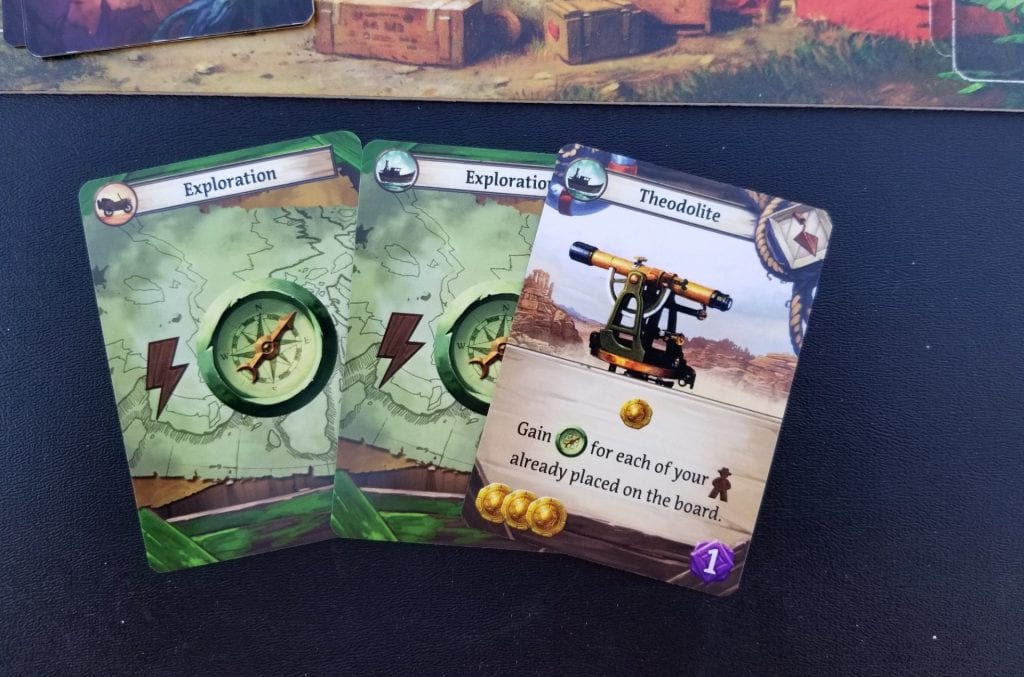
Adventurer’s Log Day 20: As the last vines fell away, the ancient temple was revealed.
As the game begins, there are only five sites available for the players to send their Archaeologist pawns. Each of these sites will require one to two boot icons* in order for a player to send one of their pawns to that location and, in true worker placement fashion, there are only a small number of spots available at each site (the number varies based on player count) that can accommodate Archaeologists. Once these spots get filled up, these sites are no longer available. The beginning sites will reward you with two coins, two compass tokens, two tablet tokens, one arrowhead token, or the ability to discard a card from your hand (i.e. play it into your playing area without using it for its icon or ability) to gain a jewel token.
*A quick note about the travel icons: there is a hierarchy for these icons and any icon further up the chain can be used in place of one further down the chain. The hierarchy is boots -> cars/boats -> airplanes. There are very few cards featuring airplane icons, but a player can always spend two coins to hire one. Cars and boats are equal and neither can stand in for the other.
Eventually the players will have enough compasses and travel icons at their disposal to discover a new site. They will pay the associated costs and place an Archaeologist from their supply onto the new site location. If they are the first to do so they will gain the Idol token that is there along with its associated bonus (if it is face up). The Idol token is then placed face down onto the player’s game mat on top of the tents (even if they do not collect the bonus from it). The reason for doing this will be made clear shortly.
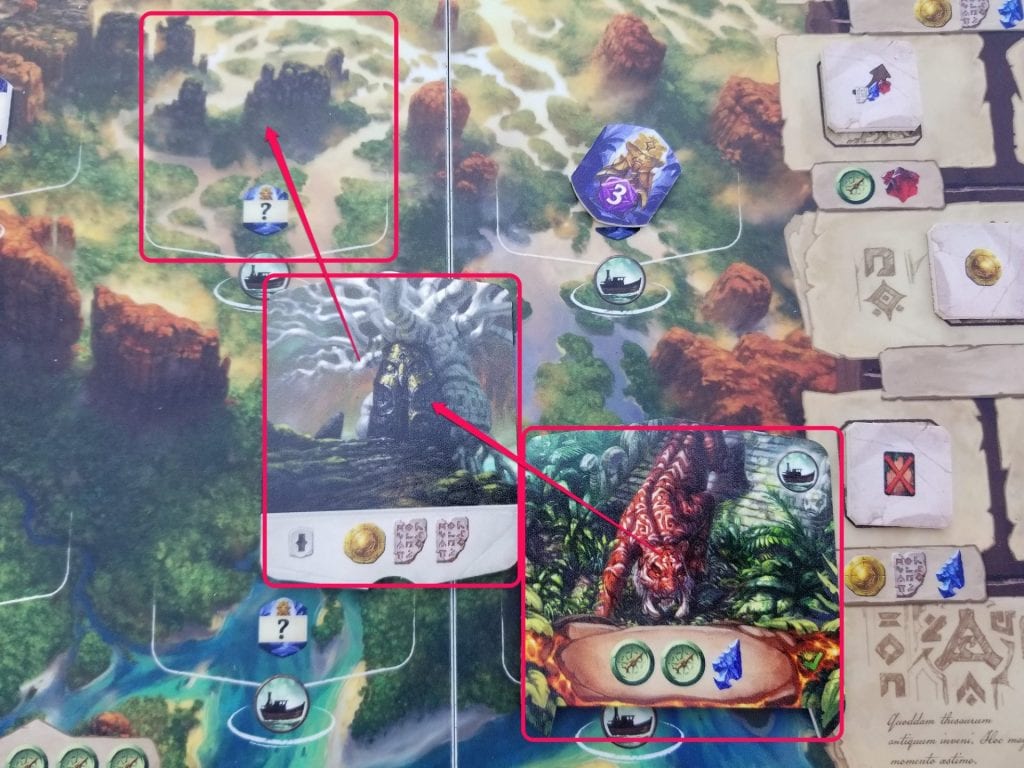
Now a Site tile is drawn and placed face up into the newly discovered site. The iconography at the bottom of the tile describes what the players receive when their Archaeologists are sent there. The player that discovered the site receives this reward immediately before drawing and placing a Guardian tile (level one for the three compass sites, level two for the six compass ones).
The Guardian tile depicts a collection of icons. These are the resources that the player must pay in order to overcome the Guardian on a later turn. If a player is able to overcome the Guardian tile, they will collect the tile and keep it face up in their player area where it will be worth five victory points at the end of the game. Most Guardian tiles also depict a one-time bonus in its upper right corner. These bonuses can be used by the player at any time. To show that it has been used, the player will flip the Guardian tile face down.
Adventurer’s Log Day 27: I read something interesting today.
During setup the players placed their Magnifying Glass and Notebook tokens at the bottom of the Research track. Using the resources they have gained, players will have the ability to move each of these tokens up the track gaining them bonuses** along the way. Each tier of the track also provides the player with victory points at the end of the game based on how far up the track each token has moved.
**There are two types of bonuses on the Research Track. There are the bonuses provided by the Research Bonus tokens which are awarded to the first player to reach a particular spot on a particular tier before being removed from the game and then there are the printed bonuses that appear to the right of each tier of the Research Track that all players will earn regardless of whether they reached a specific tier first.
There are a couple of caveats with token movement. Firstly, the Notebook token may never overtake the Magnifying Glass token (you have to see something before you can write about what you’ve seen). Secondly, there are portions of the Research track that diverge into different paths. Once you’ve begun moving a token up one of these paths, you cannot move your token to a different path until you reach a section of path that links the divergent pathways together again.
As the Notebook token enters the second tier, the bonus that it unlocks allows the player to select one of the face up Research Assistants to add to their player board. These characters provide the players with a bevy of special privileges. Some have ongoing effects while others provide once-per-round effects. These can be used for their abilities immediately or used later on at the player’s discretion. Research Assistants used in this way are turned sideways (exhausted) to show that they’ve been used.
The back sides of each of these (the gold sides) feature upgraded versions of their silver side abilities. Once the Notebook token reaches a certain tier, the bonus the player receives is the ability to refresh one of their Research Assistants and turn it to its gold side. So it is entirely possible to use a Research Assistant for its silver side ability, use the resources gained from doing so to move the Notebook token up a Research tier, use the bonus to un-exhaust and flip the Research Assistant, and then use its gold-side ability.
Once the players reach the top of the Research track, they will find themselves staring down at a new set of tiles. These two, six, and eleven point tiles are arranged in a pyramid. In front of each stack of the two point tiles are a different set of icons. In order to progress and gain one of these, the player will need to pay the resources shown and advance up that path. Then, to advance to the six-point tiles, they will need to pay the combined resources shown on the set of two point tiles directly beneath the six pointer. The eleven point tile will require the players to pay resources equal to resource costs of all three pathways.
I know that sounds a little confusing, so to better illustrate this, consider the following image:

The green player has chosen to gain the marked two point tile and must pay the circled resources. To gain the six point tile, they must pay the resources at the terminus of the blue lines. To gain the eleven point tile, they must pay the resources at the terminus of the red lines.
Adventurer’s Log Day 27: As the day draws to a close, a curiosity.
As the players discovered new sites they may have collected Idol tokens which will have been added to their player boards. In addition to their one-shot abilities, these Idols serve two more purposes. Firstly, they are worth three victory points each at the end of the game. Secondly, each Idol can be used once per game for one of five possible Idol effects: trade a coin for a ruby, take an arrowhead Token from the supply, take two tablet tokens from the supply, take a gold coin and a compass token from the supply, or draw a card and add it to your hand.
An Idol token used in this way comes at a cost, though. At the top of each player board are four Idol-shaped spaces and each of these has a victory point value printed on it. The Idol, once used, is placed onto the lowest numbered position. The only printed victory points that the player will earn at the end of the game are the ones not covered by Idol tokens.
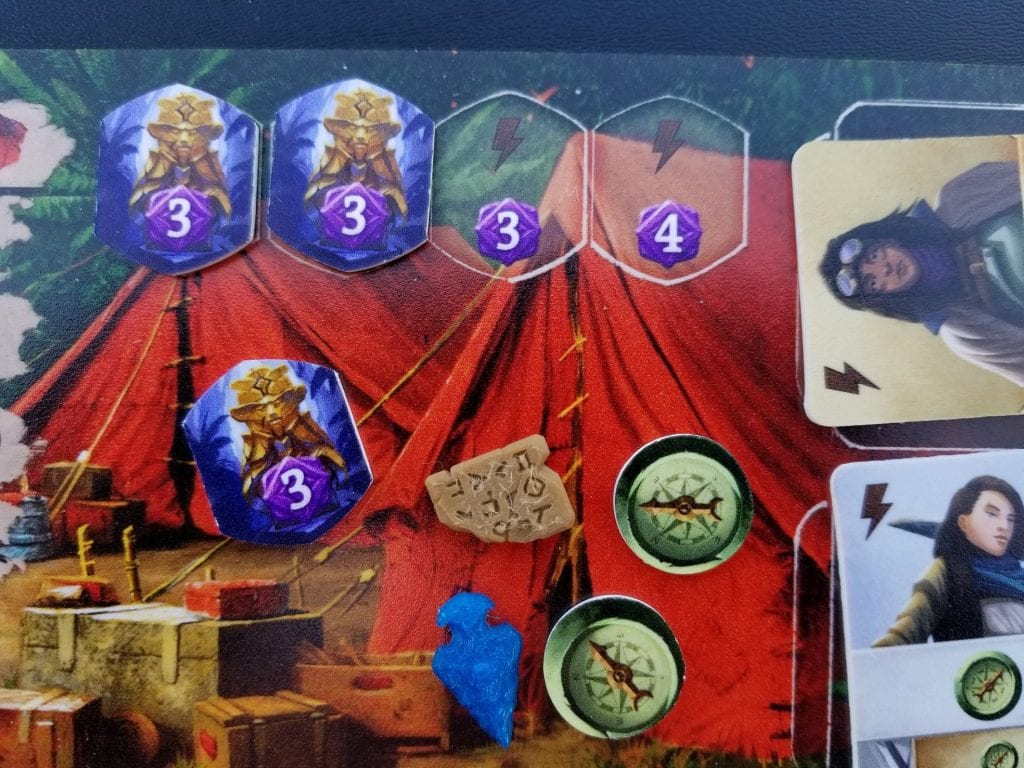
Once all players have passed, the round ends. The cards closest to the Moon Staff on either side are removed and the Moon Staff shifts one spot to the right. Then the empty holes are filled in with newly drawn cards. Any exhausted Research Assistants are refreshed. Each player’s Archaeologists are returned to them. If an Archaeologist is returned from a site that still contains a Guardian, that player has to add a Fear card to their play area. Then the cards that are left there are shuffled together along with whatever cards remain in the player’s hand (This is optional and you can hold onto cards for the next round if desired.) and placed onto the bottom of the player’s draw deck. Each player then draws a new hand of five cards to begin the next round and the Start Player marker is passed to the next person in line.
The game ends after five rounds. Victory points from the Research track, collected Guardians, Temple tiles, Idols, purchased cards, and the empty Idol slots on the player board are added together and the total from any Fear cards is deducted to arrive at your final score. The player with the most points wins.
Thoughts
Before I delve too much into what I think about Lost Ruins of Arnak, it is important to point out that the game that I received was a pre-production review copy, somewhere between a prototype and a finalized version of the game. That being said, when I opened the box that Czech Games Edition had sent to me, I was immediately blown away by the quality of the components inside. If I had to choose one word in the English language to describe them, it would be “sturdy”. From the game board, to the tokens, to the cards, to the resource bits, everything has a thick, indestructible feel about it. While I haven’t seen a production copy of the game yet, I can say that if what I received is a reflection of what the production copies are like, this is definitely a game where you’re getting your money’s worth.
Lost Ruins of Arnak isn’t just a “money’s worth” game because of its components, though. It’s the sum of its constituent parts that lends the game value. It’s a box filled to the brim not only with cardboard and plastic, but also mind-bending fun.
I said it earlier, but it bears repeating here that the way Lost Ruins of Arnak handles deckbuilding gives this game a level of strategy that most other deckbuilders do not possess. In Dominion, the most well-known example of a deckbuilder, you’re purchasing cards to add to your deck and then praying that they will eventually come out in later turns in useful combinations. While there’s definitely a level of strategy in the card selection, Dominion still largely comes down to luck of the draw. If your purchased cards come up in a good combination, then you’ll do great. But you’re equally just as likely to draw a handful of useless cards. By putting the cards directly onto the bottom of your deck and allowing you to hold cards between rounds, Lost Ruins of Arnak makes your strategic card acquisitions even more strategic. You’ll typically have a decent idea of at least some of the cards that will be available to you in the upcoming round and that goes a long way towards determining what you hope to achieve in this round.
I’m a big fan of deckbuilders in general. I like how fulfilling it is when I am able to chain a bunch of actions together to create a long and satisfying turn. I liken it to the feeling I get when I am playing an engine building game where the output of the engine evolves exponentially over time — like the way the engines work in Lorenzo il Magnifico. Lost Ruins of Arnak does this very well. Game designers Min and Arwen could have just stopped there and I would be satisfied with the experience. But they didn’t.
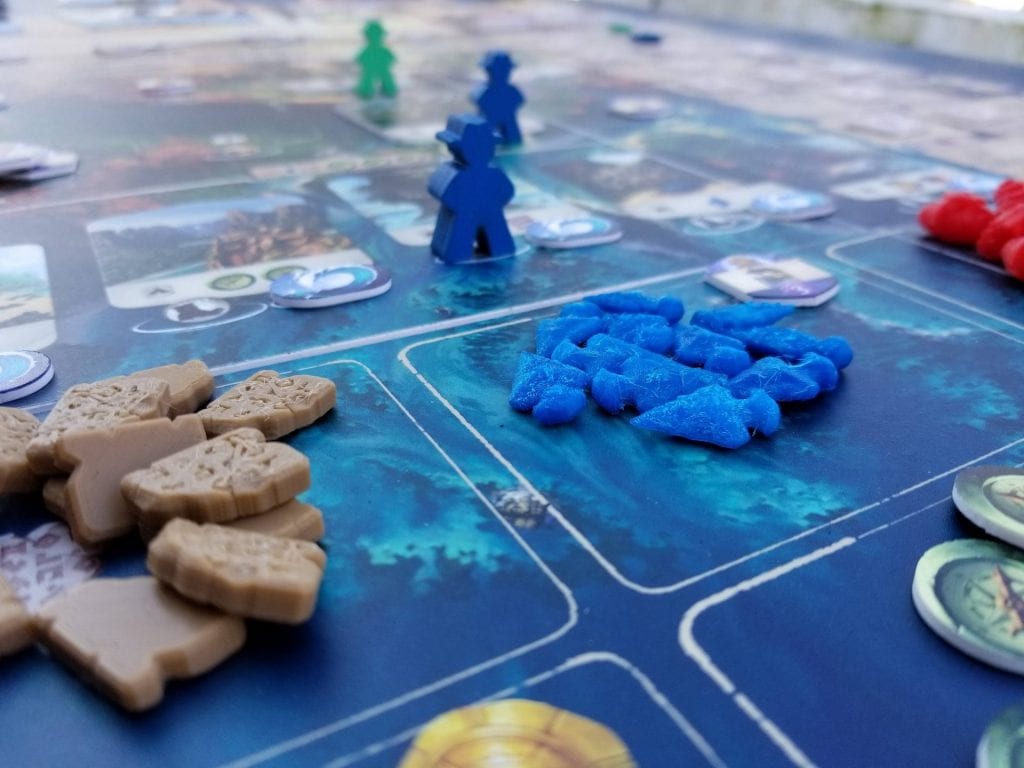 Each mechanic in the game meshes with the other mechanics beautifully, like disparate notes in a symphony. This is largely due to the theme. The theme is what initially drew me to the game and the game absolutely oozes with it. Lost Ruins of Arnak makes me feel like I am managing an expeditionary force of explorers and anthropologists. Not only am I handling the people, but I am also managing the logistical drudgery that gets them from point A to point B: fuel, resources, and transportation. While one group of people is sent off to discover new things, another remains behind at the latest discovery to chronicle everything we’ve found out. I went into Lost Ruins of Arnak expecting Indiana Jones, but what I found was an appealing mixture of Hollywood fantasy and sobering reality. However, all the boring stuff is abstracted just enough so that you don’t get bogged down in the minutiae, but those details are still there all the same.
Each mechanic in the game meshes with the other mechanics beautifully, like disparate notes in a symphony. This is largely due to the theme. The theme is what initially drew me to the game and the game absolutely oozes with it. Lost Ruins of Arnak makes me feel like I am managing an expeditionary force of explorers and anthropologists. Not only am I handling the people, but I am also managing the logistical drudgery that gets them from point A to point B: fuel, resources, and transportation. While one group of people is sent off to discover new things, another remains behind at the latest discovery to chronicle everything we’ve found out. I went into Lost Ruins of Arnak expecting Indiana Jones, but what I found was an appealing mixture of Hollywood fantasy and sobering reality. However, all the boring stuff is abstracted just enough so that you don’t get bogged down in the minutiae, but those details are still there all the same.
It just works.
Each time that I have played this game, I have felt myself tested at every turn as I am forced to make agonizing decisions. Where should I send my Archaeologists? Do I want to take a spot for myself or take a spot that I know my opponent wants to take? (Full disclosure: because of the pandemic, I have only ever played Lost Ruins of Arnak at the two player count) Should I use an Idol for its ability now or hang onto it for later and hope that maybe I won’t have to? How can I milk this round the most effectively? Do I play all of my cards for one big move or parcel them out for smaller ones? With only five cards and two Archaeologists at your command, your choices become more critical than they would in a game where you have a whole army of workers at your disposal. And those choices are never easy. It’s a difficulty borne of tough choices and not of overly complex rules and bloated mechanics. I really like that.
If it weren’t already apparent, I am a fan of Lost Ruins of Arnak. After multiple plays just trying to find anything, anything at all, negative to say about it, I have come away with mostly glowing positivity. In fact, my only critique would be with the choice of compasses to represent the passage of time. If we’re trying to be thematic here, little stopwatches or sundials would have made more sense. Regardless, no matter how many compasses you choose to spend with Lost Ruins of Arnak, it is time well spent.


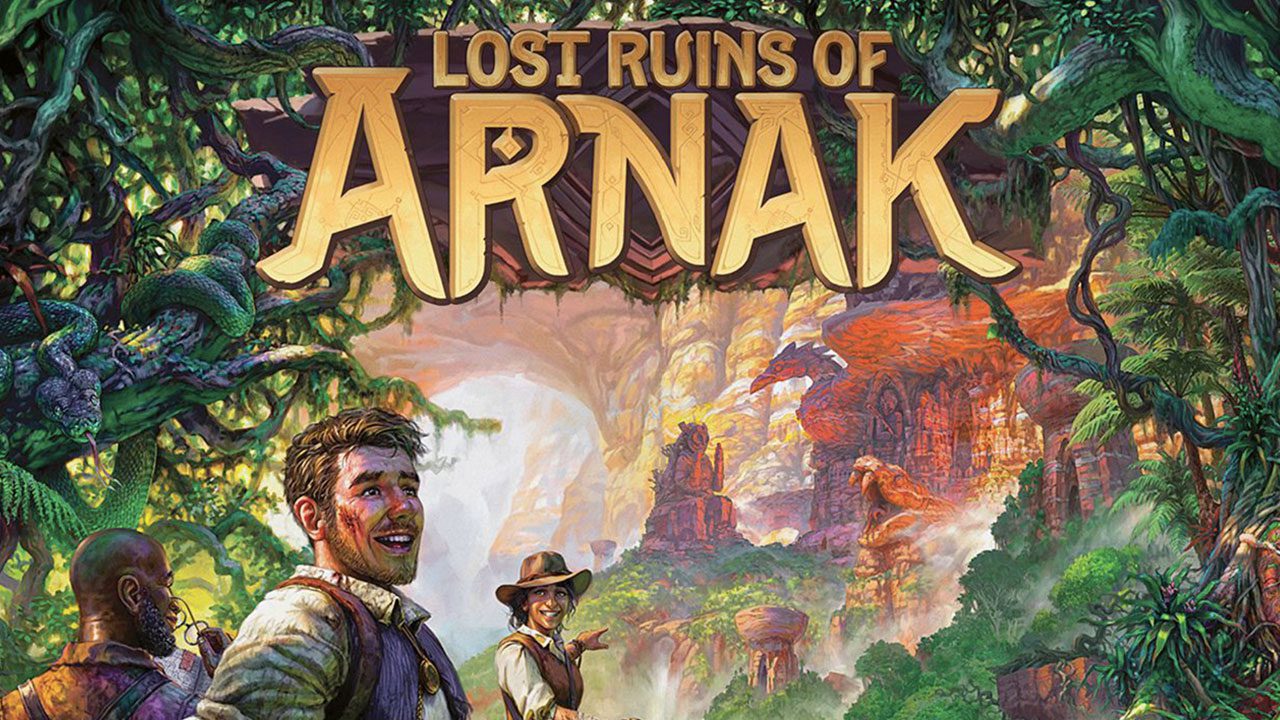




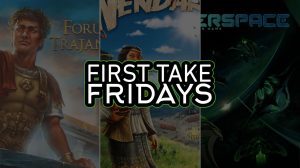




Add Comment